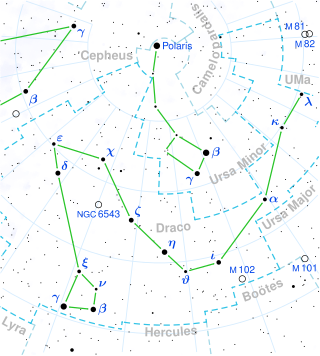Omicron Draconis (Latinised as ο Draconis, abbreviated to ο Dra) is a giant star in the constellation Draco located 322.93 light years from the Earth. Its path in the night sky is circumpolar for latitudes greater than 31o north, meaning the star never rises or sets when viewed in the night sky.

This is a single-lined spectroscopic binary system,[7] but the secondary has been detected using interferometry. It is an RS Canum Venaticorum variable system with eclipses. The total amplitude of variation is only a few hundredths of a magnitude.[8][4] The secondary star is similar to the Sun, presumably a main sequence star, while the primary is a giant star 25 times larger than the Sun and two hundred times more luminous.
- ^ a b c d e Van Leeuwen, F. (2007). "Validation of the new Hipparcos reduction". Astronomy and Astrophysics. 474 (2): 653–664. arXiv:0708.1752. Bibcode:2007A&A...474..653V. doi:10.1051/0004-6361:20078357. S2CID 18759600.
- ^ a b Hoffleit, Dorrit; Jaschek, Carlos (1991). "The Bright star catalogue". New Haven. Bibcode:1991bsc..book.....H.
- ^ a b Keenan, Philip C.; McNeil, Raymond C. (1989). "The Perkins catalog of revised MK types for the cooler stars". Astrophysical Journal Supplement Series. 71: 245. Bibcode:1989ApJS...71..245K. doi:10.1086/191373.
- ^ a b c d e f g h i j k l m n o p Roettenbacher, Rachael M.; Monnier, John D.; Fekel, Francis C.; Henry, Gregory W.; Korhonen, Heidi; Latham, David W.; Muterspaugh, Matthew W.; Williamson, Michael H.; Baron, Fabien; Ten Brummelaar, Theo A.; Che, Xiao; Harmon, Robert O.; Schaefer, Gail H.; Scott, Nicholas J.; Sturmann, Judit; Sturmann, Laszlo; Turner, Nils H. (2015). "Detecting the Companions and Ellipsoidal Variations of RS CVn Primaries. II. O Draconis, a Candidate for Recent Low-mass Companion Ingestion". The Astrophysical Journal. 809 (2): 159. arXiv:1507.03601. Bibcode:2015ApJ...809..159R. doi:10.1088/0004-637X/809/2/159. S2CID 119228345.
- ^ Karataș, Yüksel; Bilir, Selçuk; Eker, Zeki; Demircan, Osman; Liebert, James; Hawley, Suzanne L.; Fraser, Oliver J.; Covey, Kevin R.; Lowrance, Patrick; Kirkpatrick, J. Davy; Burgasser, Adam J. (2004). "Kinematics of chromospherically active binaries and evidence of an orbital period decrease in binary evolution". Monthly Notices of the Royal Astronomical Society. 349 (3): 1069–1092. arXiv:astro-ph/0404219. Bibcode:2004MNRAS.349.1069K. doi:10.1111/j.1365-2966.2004.07588.x. S2CID 15290475.
- ^ a b Cite error: The named reference
BohmVitense2000was invoked but never defined (see the help page). - ^ a b Cite error: The named reference
aaa398_1163was invoked but never defined (see the help page). - ^ Cite error: The named reference
IVSIwas invoked but never defined (see the help page).
